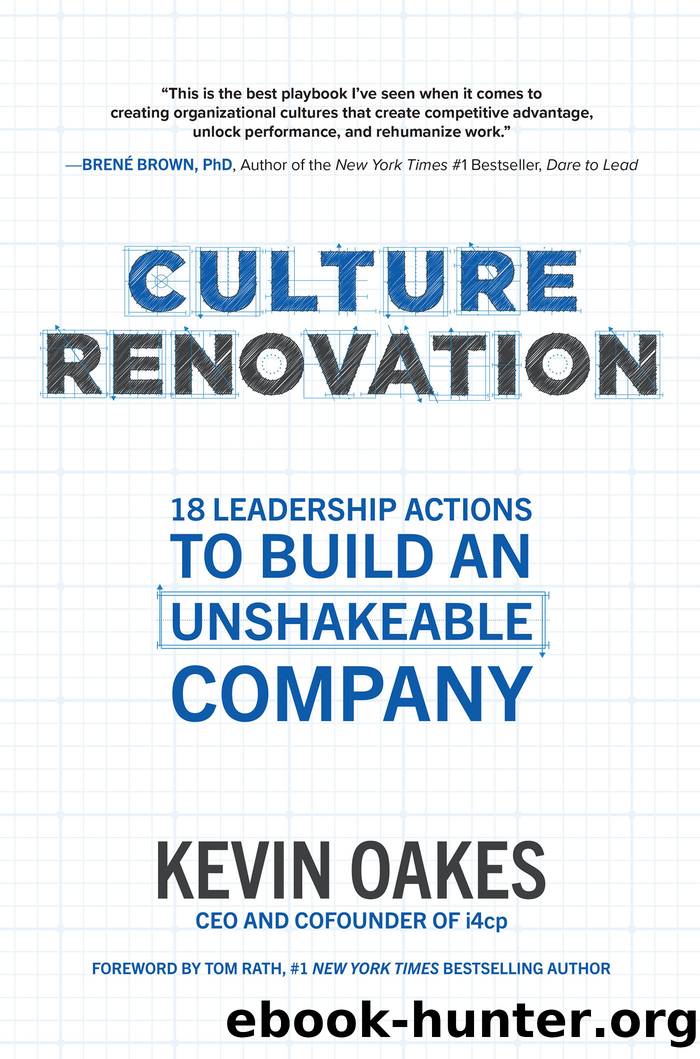Culture Renovation: 18 Leadership Actions to Build an Unshakeable Company by Kevin Oakes

Author:Kevin Oakes [Kevin Oakes]
Language: eng
Format: epub
Publisher: McGraw-Hill
Published: 2021-01-11T16:00:00+00:00
Master Craftsman
In nearly all highly successful culture change efforts (89 percent), the CEO made a commitment to the future vision by dedicating the necessary resources and time toward the renovation. This included both organizational resources and the CEOâs own personal resourcesâmost importantly, time, attention, and action. At organizations that report a highly successful culture change, this often translates to a regular cadence of communication events, such as CEO-led all-company (town hall) meetings to discuss the vision for the future. Good CEOs typically lead meetings about change in different company locations and with a variety of functional levels. They also meet with senior-level cross-organization teams to transparently share feedback gathered from different regions, units, and so on.
Pat Wadors of Procore shared with me one day how, in a previous role, the companyâs CEO regularly brought up anecdotal stories about the why and what of the change when visiting customers, spending time with employees at various sites, or just walking around the office. âEventually, it becomes part of your mantra,â said Wadors. âItâs woven in. Whether [the CEO] was having a fireside chat with our sales or engineering teams, our ongoing transformation is what he wove in every single time.â
âThe premise for acknowledging your roots, your history, is really based on the emotional science around grieving,â Wadors explains. âYou canât move forward from grief unless you acknowledge what you had to do to get to the next chapter. And the stories that you tell yourself, and the impact that person or that thing had on you and your lifeâyouâve got to be able to celebrate it, understand what it is, and then put it to bed to get to the next chapter. And those people that donât give that nod have a really hard time transitioning. And have a hard time accepting a new reality.â
âItâs the same with culture change, because often employees feel that if new leaders come in and just paint a new picture, they feel itâs disrespectful,â Wadors told me. âLike, youâre standing on the shoulders of other great people. You wouldnât have this privilege if it werenât for what we did in the past. Theyâll keep defending their history until you acknowledge the history. As a leader, youâve got to acknowledge the history, but also acknowledge that what got us here may not necessarily get us to where we want to go. Youâve got to paint a picture of the future that others can see themselves in. And the only way theyâre going to see themselves in that picture is if they helped create it.â
Helping guide the workforce toward that vision is often more art than science.
âReally great craftsmen do that well,â observed Wadors. âThey bring people through a facilitation, and they have some of the guardrails already in place, so people get to paint within the lines. There are lines drawn, but the facilitator doesnât make those lines so obvious to others. So, they feel like they have more freedom than they probably do. But itâs like almost a presumptive close.
Download
This site does not store any files on its server. We only index and link to content provided by other sites. Please contact the content providers to delete copyright contents if any and email us, we'll remove relevant links or contents immediately.
Time Management Made Easy: How to Cultivate New Habits, Improve Productivity and Get Things Done by Joshua Strachan(2365)
The 7 Habits of Highly Effective People by Stephen R. Covey & Sean Covey(2098)
The Concise Laws of Human Nature by Robert Greene(1712)
Doesn't Hurt to Ask by Trey Gowdy(1555)
Primal Leadership by Daniel Goleman(1124)
Hook Point: How to Stand Out in a 3-Second World by Brendan Kane(1098)
HBR's 10 Must Reads 2021 by unknow(1044)
Don't Sweat the Small Stuff...and It's All Small Stuff by Richard Carlson(1012)
Amazon Unbound by Brad Stone(979)
100 Things Successful People Do by Nigel Cumberland(963)
HBR's 10 Must Reads 2021 by Harvard Business Review(955)
The Job Closer by Steve Dalton(937)
Master of One by Jordan Raynor(934)
Lives of the Stoics by Ryan Holiday & Stephen Hanselman(899)
Declutter Your Mind: A step by step guide to learn to control your thoughts, stop worrying, relieve anxiety and eliminate panic attacks and negative thinking by Mia Chandler(875)
The Power of 100! by Shaun King(842)
Conflicted by Ian Leslie(798)
Coders at Work: Reflections on the craft of programming by Peter Seibel(787)
The Book of Hope by Jane Goodall(743)
